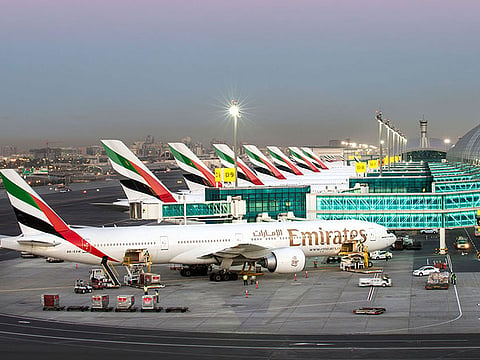What next for Emirates?
After 30 years, Emirates will have to continue to demonstrate its economic and consumer benefits

Dubai: Emirates celebrates its 30th anniversary on Sunday, October 25, marking its journey from a small Middle Eastern airline with just two leased aircraft to the world’s largest carrier on international routes.
Emirates no longer flies narrow-bodied aircraft like the Boeing 727-200, one of types of the aircraft it leased from Pakistan International Airlines in 1985. Instead, it boasts the world’s largest wide-body fleet of Boeing 777’s and Airbus A380’s.
Over 30 years, airline has navigated through tumultuous headwinds, including two Gulf wars and several financial crises. But this year it faced a new challenge when the three largest carriers in the United States launched an aggressive campaign against Gulf carriers.
American, United and Delta have lobbied the US government to curtail the growth of the Gulf carriers, claiming they are subsidised to the tune of tens of billions of dollars. The Gulf carriers have denied the allegations and the lobbying efforts have had little to no impact. Emirates eventually hit back at the US airlines with a tongue-in-cheek advertisement with Hollywood actress Jennifer Aniston.
But John Strickland, a respected aviation expert and director of London-based JLS Consulting, said Emirates’ biggest challenge is “not opportunity but dealing with the political and regulatory challenges it faces in some parts of the world.”
Emirates has faced opposition in other markets including in Europe, led by two of the continents largest carriers Lufthansa and Air France-KLM.
“[Emirates] will have to fight these battles by continuing to demonstrate and communicate the economic and consumer benefits it brings when it enters or indeed creates a new market,” Strickland said.
Legacy carriers are threatened by the rapid growth of Emirates — and other Gulf carriers Etihad Airways and Qatar Airways. The three airlines have been able to grow passenger traffic between Europe and Asia and Australia “beyond what carriers in those part of the world could do,” Will Horton, senior analyst at CAPA – Centre for Aviation, told Gulf News by email.
But some airlines have seen the attraction of Emirates. In 2013, Qantas ditched its 17-year partnership with British Airways to tie-up with Emirates and fly to London via Dubai.
Horton said Qantas is the only airline that has found a way to compete with Gulf carriers. Join them. But other legacy airlines have shown “no comprehensive strategy yet to overcome” the Gulf carriers, Horton said.
The growth of the Gulf carriers — led by Emirates — has transformed the region into a major, intercontinental hub for East-West traffic. And it’s not just Emirates and Dubai. It is Etihad Airways and Abu Dhabi and Qatar Airways and Doha too.
Emirates’ hub, Dubai International, last year became the world’s busiest airport for international passengers, overtaking London Heathrow, which the airline started flights to in 1991.
Emirates growth has put pressure on Dubai International operator Dubai Airports, its chief executive Paul Griffiths Gulf News said in an interview in September 2015, but he added that working with the airline is “a pleasure.”
“We continue to raise our game to meet their expectations,” he said.
And as the Gulf airlines, including Emirates, continue to transform their hubs it is not only the legacy airlines that have taken notice.
“For new economies — such as China — building hubs, the references aren’t just legacy hubs in Europe and North America but also Dubai, Doha and Abu Dhabi,” Horton said.
Next year, Emirates will launch the world’s longest flight from Dubai to Panama City in South America, a continent the airline so far has very few flights to but where executives have alluded to the possibilities.
Emirates “revolutionised the aviation sector,” Strickland said by taking “entrepreneurial risks in developing new markets, where opportunity was not always apparent.”
“The Emirates model” has focused on operating large, wide-body aircraft, and executives have so far shown no interest in flying smaller aircraft.
“There is risk of complacency but signs of change. As the world’s largest international airline, the tyranny of size naturally threatens agility and efficiency,” Horton said by email.
Regional competitor Qatar Airways, which does fly smaller aircraft, pips Emirates on total number of passenger destinations served, 137, compared to Emirates 132.
But Emirates is reviewing an order for the Airbus A350 and the Boeing Dreamliner 787, both smaller than the 777 and A380 but still wide-body aircraft, which would allow the airline to access markets that are not big enough for the 777 or A380.
“A narrow-body operation can bring new points to the network, but that’s not necessarily ‘the Emirates model,’” Horton said.
And in an April interview, Emirates President Tim Clark told Gulf News there is still “plenty more to do on the same business model.”
Sign up for the Daily Briefing
Get the latest news and updates straight to your inbox



